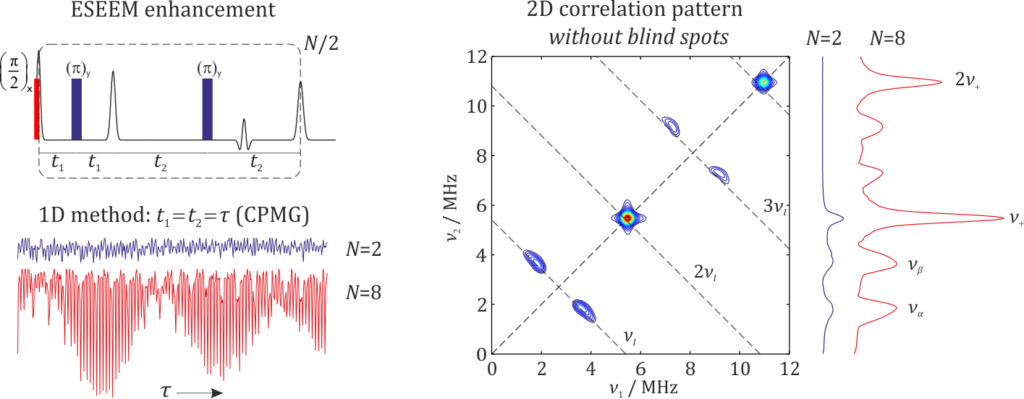Pulse EPR methodology
The electron spin echo envelope modulation (ESEEM) effect is the key element of many powerful pulsed EPR techniques that are used to determine weak hyperfine and nuclear quadrupole interactions in solids. These include methods that are based on electron spin coherence like the primary two-pulse and refocused primary echo sequences, or schemes that are based on evolution of nuclear spin coherence like three-pulse, four-pulse, hyperfine sublevel correlation (HYSCORE) and double nuclear coherence transfer (DONUT)-HYSCORE. While some of these methods provide optimum resolution for given paramagnetic systems, they may suffer from poor sensitivity due to small modulation depths, low abundances of magnetic nuclei and/or additional multinuclear suppression effects. For this reason, the development of methods with improved sensitivity or towards resolution enhancement is an important field of modern EPR spectroscopy.
Modulation depth enhancement using pulse trains

In the present work we study a new way to increase the modulation amplitude of ESEEM experiments by applying multiple refocusing π-pulses on the electron spin coherence created initially by a π/2-pulse. Each one of these pulses redistributes the electron spin coherence among allowed and forbidden EPR transitions and this in turn leads to a significant enhancement of the ESEEM effect, depending on the strength of the hyperfine interaction and the number of applied pulses, N. We derive analytical expressions for a general two-dimensional (2D) scheme and we explore the expected modulation enhancement of various correlation peaks as a function of k (modulation depth parameter) and N. Our study shows that these methods are particularly useful for detecting weak hyperfine couplings of magnetic nuclei having small gn factors and low natural abundances like 13C and 29Si.
Reference
Modulation depth enhancement of ESEEM experiments using pulse trains, G. Mitrikas, G. Prokopiou, J. Magn. Reson. 254, 75-85 (2015) DOI: 10.1016/j.jmr.2015.03.002